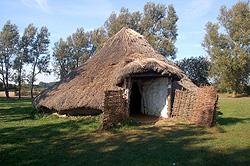Prehistoric Woburn

A reconstruction of an Iron Age round house at Flag Fen October 2011
The Bedfordshire Historic Environment Record [HER] contains information on the county’s historic buildings and landscapes and summaries of each entry can now be found online as part of the Heritage Gateway website. Woburn, like neighbouring Aspley Guise, is not rich in ancient sites. The only four possible prehistoric sites in the parish have been identified, two of them solely from cropmarks. Square and circular marks [HER 14703] have been identified just west of the brook running north-west of The Birch public house and similarly shaped cropmarks have been identified east of Sheep Lane [HER 14707]. Both these can only be tentatively identified as prehistoric and await field walking or excavation to prove the hypothesis.
Prehistoric remains were discovered when building the elephant enclosure for the safari park, north-east of Dean Hills in Woburn Park on the boundary with Husborne Crawley [HER 16507]. A series of ditched enclosures dating to the middle Iron Age were excavated producing plant remains, a blade, a flint core, four flint flakes, some pieces of pottery and some slag from iron working. Flint tools continued to be used long after the Stone Age because they were easier to make then metal tools and, in Bedfordshire, at least, the raw material was plentiful.
An area of Anglo-Saxon and Norman settlement north of Horsemoor Farm [HER 13499] also included a few prehistoric finds. These comprised a flint flake, and some pottery, one piece being datable only to the general prehistoric era, another piece being late Neolithic or early Bronze Age and another dating from the late Iron Age.